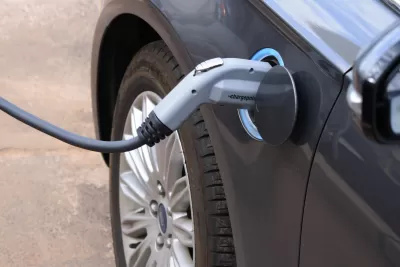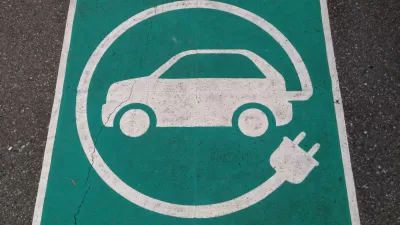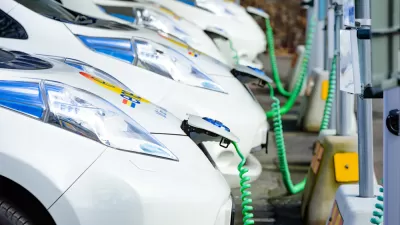The U.S. needs more charging infrastructure to support the electrification of the transportation sector. This toolkit is a good step in the right direction. But electric vehicles and charging infrastructure are no panacea to our transportation woes.

The U.S. Department of Transportation released a toolkit earlier this month that outlines how rural communities can use funds from the Infrastructure Investment and Jobs Act (IIJA) to build out electric vehicle infrastructure.
Deeper dive: The bipartisan infrastructure law provides $7.5 billion for building out an EV charging network across America. In a state like Wisconsin (my home), the infrastructure law will bring $79 million in federal funds to the state to support the creation of a statewide EV charging network.
The guide aims to:
- Connect and empower a variety of rural stakeholders—including states, local communities, Tribal nations, transportation providers, non-profits, businesses, and labor leaders—with the tools and information they need to start planning and implementing EV infrastructure projects.
- Outline how to build the groundwork for light-duty electric passenger vehicles—like sedans, sport utility vehicles, and pickup trucks—and addresses funding opportunities and planning considerations for public transit, school buses, and agricultural equipment like tractors.
Why it matters: Rural parts of the country are home to 20 percent of Americans and almost 70 percent of America’s road miles. Rural residents drive more than their urban counterparts, spend more on vehicle fuel and maintenance, and often have fewer alternatives to driving to meet their transportation needs. EVs can be an especially attractive alternative to conventional vehicles.
But, but, but: Higher vehicle costs, range anxiety, and a lack of charging infrastructure are top barriers to widespread EV adoption. This toolkit only helps overcome two of these barriers.
- Vehicle Costs: The upfront cost of electric vehicles remains higher than those of internal combustion engine vehicles. The average transaction price for an electric vehicle is $56,437, according to Kelley Blue Book—roughly $10,000 higher than the overall industry average of $46,329 that includes gas-powered vehicles and EVs. In terms of pricing, an EV is equivalent to an entry-level luxury car. More rural EV charging infrastructure will do little to drive down vehicle costs.
- Range anxiety: A major concern for drivers is the distance electric vehicles can travel without a charge. Most new sedan and light-duty truck models planned to launch through 2025 have a range of 250-300 miles per charge, plenty of range for regional driving. As battery technology improves, vehicle ranges will increase. No doubt, current battery limits and range anxiety can be offset with more charging options.
- Lack of charging infrastructure: How, when, and where the vehicle can be charged is a serious and expensive barrier to overcome. The U.S. currently has a total of nearly 43,000 public EV charging stations and around 120,000 charging ports, according to 2021 reporting by Reuters. Also, chargers are distributed very unevenly across the country, with California having nearly the same amount of charging stations as the 39 states with the lowest count combined. No doubt these funds and this toolkit will improve distribution and increase charging options.
- Perspective: The European Union currently has nearly 275,000 EV charging ports, according to data by the European Alternative Fuels Observatory, or around 62 charging points per 100,000 inhabitants. The United States has roughly 37 ports on the same per-capita basis.
Zoom Out: The transportation sector is the largest contributor to greenhouse gas emissions in the United States. But it will take more than just replacing gas guzzlers to reduce transportation-sourced emissions.
- Transportation greenhouse gas emissions are a result of what the Center for Clean Air Policy (CCP) refers to as a ‘three-legged stool’: vehicles, fuels, and vehicle miles traveled. Critical to any successful transportation decarbonization plan is a three-pronged strategy that encourages technology advancements and influences consumer choices about transportation mode, fuel sourcing, and miles driven.
- Expanding charging infrastructure will help EV owners deal with range anxiety and improve charging options. But increasing charging infrastructure does little to reduce vehicle miles traveled. It also does little to decarbonize fuel sources. An EV is only as green as the fuel that feeds it, and fossil fuels—petroleum, natural gas, and coal—accounted for about 79% of total U.S. primary energy production in 2020. You can zoom in here for more to think about.
Bottom line: This toolkit and these funds are a good step in the right direction. The U.S. needs more charging infrastructure to support the electrification of the transportation sector. But EVs and charging infrastructure are no panacea to our transportation woes.

Planetizen Federal Action Tracker
A weekly monitor of how Trump’s orders and actions are impacting planners and planning in America.

Maui's Vacation Rental Debate Turns Ugly
Verbal attacks, misinformation campaigns and fistfights plague a high-stakes debate to convert thousands of vacation rentals into long-term housing.

San Francisco Suspends Traffic Calming Amidst Record Deaths
Citing “a challenging fiscal landscape,” the city will cease the program on the heels of 42 traffic deaths, including 24 pedestrians.

Amtrak Rolls Out New Orleans to Alabama “Mardi Gras” Train
The new service will operate morning and evening departures between Mobile and New Orleans.

The Subversive Car-Free Guide to Trump's Great American Road Trip
Car-free ways to access Chicagoland’s best tourist attractions.

San Antonio and Austin are Fusing Into one Massive Megaregion
The region spanning the two central Texas cities is growing fast, posing challenges for local infrastructure and water supplies.
Urban Design for Planners 1: Software Tools
This six-course series explores essential urban design concepts using open source software and equips planners with the tools they need to participate fully in the urban design process.
Planning for Universal Design
Learn the tools for implementing Universal Design in planning regulations.
Heyer Gruel & Associates PA
JM Goldson LLC
Custer County Colorado
City of Camden Redevelopment Agency
City of Astoria
Transportation Research & Education Center (TREC) at Portland State University
Jefferson Parish Government
Camden Redevelopment Agency
City of Claremont





























